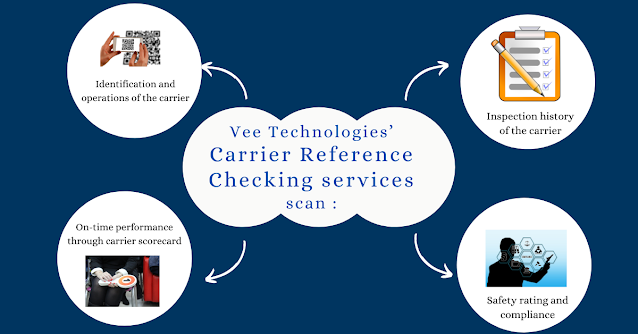 |
| Carrier Reference Checking services |
Vee Technologies offers #CarrierReferenceChecking services that run a background check on the carrier who signed for our client’s shipment.
Email : info@veetechnologies.com
Get updates on Logistics service providers that manage and resolve A-Z Logistics problems
 |
| Carrier Reference Checking services |
Vee Technologies offers #CarrierReferenceChecking services that run a background check on the carrier who signed for our client’s shipment.
Email : info@veetechnologies.com
Vee Technologies’ Freight Weight Reconciliation Service ensures that the weight is accurately calculated for all types of freight.
 |
| Driver Log Management and DOT Guidelines |
The US Department of Transportation (DOT) has regulations and guidelines for driver log maintenance. A driver log is a document used to monitor and record the daily trips and activities of the drivers like bus drivers, train drivers, company drivers, and taxi drivers. It is a record to ensure they are doing their work well. It is also a record to have a check on their Hours of Service (HOS), for which DOT has strict guidelines.
Drive logs are maintained in two ways: paper logs and electronic logs.
Paper log vs. electronic log
Paper logs are the traditional system that drivers use to mark their daily activities. Paper logs are manually filled and take more time, which eventually causes low productivity. Drivers can be potentially forced to overwork and get exhausted, as there is only a paper record that they fill. And these are also difficult to audit, analyze, and manage.
On the other hand, electronic log/e-log/Electronic Logging Devices (ELD). They automatically record driving hours when the vehicle starts, cuts down the work pressure on the drivers, and save time spent on paperwork. It can also notify the drivers when to take a break, map and plan the route, monitor fuel, and more.
Necessity of ELD
The US government’s ELD rule primarily applies to commercial vehicle drivers and carriers who are maintaining records of duty status (RODS), to ensure they are not exceeding the working time and rest time.
Hours of Service (HOS) and DOT regulations
Drivers of commercial motor vehicles (CMVs) should follow the guidelines for the number of hours they are allowed to drive. They should record both driving and non-driving hours. The following are the rules for HOS of drivers transporting property:
1. Driving limit of 11 hours: After 10 hours of being at rest/off duty, the drivers can drive a maximum of the next 11 hours.
2. 14-hour limit: A driver should not go beyond 14 hours straight after resuming duty after 10 hours off duty. This 14-hour limit cannot be extendable by the time off duty.
3. Rest breaks: Drivers are allowed to drive under the condition that they have worked for 8 hours since their off duty or sleeper berth duration of not less than 30 minutes.
4. 60/70-hour limit: Drivers should not drive after being on duty for 60-70 hours in 7-8 consecutive days. Once they are off duty for 34 hours or more consecutively, they can restart their work shift for the next 7-8 days.
Improvement in business productivity
• Automatic record of duty timing and reduces paper errors.
• Inspection is easier with a digital display of data.
• Prevents violation of HOS by alerting the drivers before exceeding the time limit.
• Simplified data maintenance scheduling and send issue alerts.
Drive log management and its regulations enable the driver to be safe and productive. Electronic logs can reduce the operating cost by 10% and driver compliance by 28%, a study report. It does not only protect the driver from taking advantage of but also helps the owners by maintaining compliance and reducing costs.